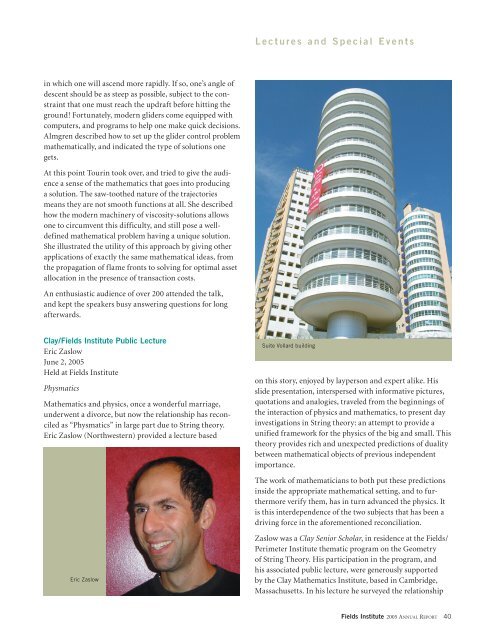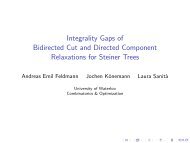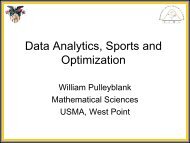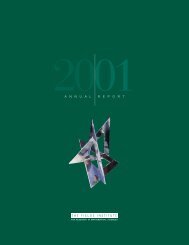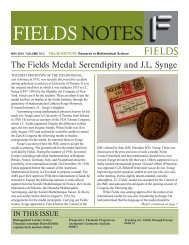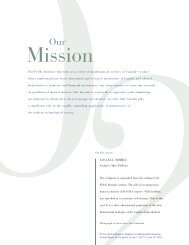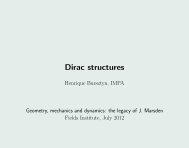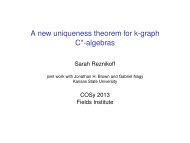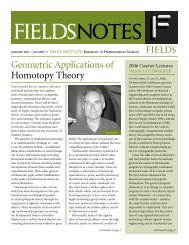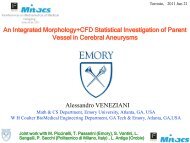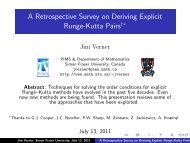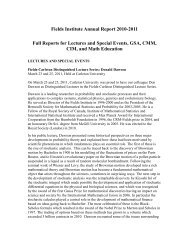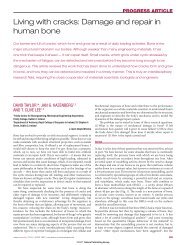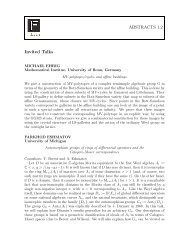Annual Report 2005 - Fields Institute - University of Toronto
Annual Report 2005 - Fields Institute - University of Toronto
Annual Report 2005 - Fields Institute - University of Toronto
You also want an ePaper? Increase the reach of your titles
YUMPU automatically turns print PDFs into web optimized ePapers that Google loves.
in which one will ascend more rapidly. If so, one’s angle <strong>of</strong><br />
descent should be as steep as possible, subject to the constraint<br />
that one must reach the updraft before hitting the<br />
ground! Fortunately, modern gliders come equipped with<br />
computers, and programs to help one make quick decisions.<br />
Almgren described how to set up the glider control problem<br />
mathematically, and indicated the type <strong>of</strong> solutions one<br />
gets.<br />
At this point Tourin took over, and tried to give the audience<br />
a sense <strong>of</strong> the mathematics that goes into producing<br />
a solution. The saw-toothed nature <strong>of</strong> the trajectories<br />
means they are not smooth functions at all. She described<br />
how the modern machinery <strong>of</strong> viscosity-solutions allows<br />
one to circumvent this difficulty, and still pose a welldefined<br />
mathematical problem having a unique solution.<br />
She illustrated the utility <strong>of</strong> this approach by giving other<br />
applications <strong>of</strong> exactly the same mathematical ideas, from<br />
the propagation <strong>of</strong> flame fronts to solving for optimal asset<br />
allocation in the presence <strong>of</strong> transaction costs.<br />
An enthusiastic audience <strong>of</strong> over 200 attended the talk,<br />
and kept the speakers busy answering questions for long<br />
afterwards.<br />
Clay/<strong>Fields</strong> <strong>Institute</strong> Public Lecture<br />
Eric Zaslow<br />
June 2, <strong>2005</strong><br />
Held at <strong>Fields</strong> <strong>Institute</strong><br />
Physmatics<br />
Mathematics and physics, once a wonderful marriage,<br />
underwent a divorce, but now the relationship has reconciled<br />
as “Physmatics” in large part due to String theory.<br />
Eric Zaslow (Northwestern) provided a lecture based<br />
Eric Zaslow<br />
L e c t u r e s a n d S p e c i a l E v e n t s<br />
Suite Vollard building<br />
on this story, enjoyed by layperson and expert alike. His<br />
slide presentation, interspersed with informative pictures,<br />
quotations and analogies, traveled from the beginnings <strong>of</strong><br />
the interaction <strong>of</strong> physics and mathematics, to present day<br />
investigations in String theory: an attempt to provide a<br />
unified framework for the physics <strong>of</strong> the big and small. This<br />
theory provides rich and unexpected predictions <strong>of</strong> duality<br />
between mathematical objects <strong>of</strong> previous independent<br />
importance.<br />
The work <strong>of</strong> mathematicians to both put these predictions<br />
inside the appropriate mathematical setting, and to furthermore<br />
verify them, has in turn advanced the physics. It<br />
is this interdependence <strong>of</strong> the two subjects that has been a<br />
driving force in the aforementioned reconciliation.<br />
Zaslow was a Clay Senior Scholar, in residence at the <strong>Fields</strong>/<br />
Perimeter <strong>Institute</strong> thematic program on the Geometry<br />
<strong>of</strong> String Theory. His participation in the program, and<br />
his associated public lecture, were generously supported<br />
by the Clay Mathematics <strong>Institute</strong>, based in Cambridge,<br />
Massachusetts. In his lecture he surveyed the relationship<br />
<strong>Fields</strong> <strong>Institute</strong> <strong>2005</strong> ANNUAL REPORT 40


